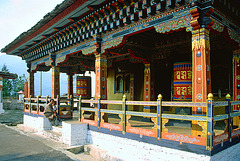Wolfgang's photos
Moray looks out its housing
Diving in Burma 33
| |
|
Heniochus fish over a coral bank
| |
|
|
The Black and White Heniochus Butterfly Fish is also known as the poor man's Moorish Idol. While the Black and White Heniochus Butterfly Fish looks similar to the Moorish Idol the Black and White Heniochus is significantly different. It is much easier to care for captivity and is one of the hardier butterfly fishes available. They are very attractive with black and white broad stripes and long streaming dorsal fins much like those of the Moorish idol.
Diving in Burma 35
| |
|
Diving in Burma Mergui Archipelago
| |
|
We wanted the most unique Burma diving experience in the planet, Burma is the right place for us. Its waters were closed off until 1997, which means that they are relatively unexplored and undiscovered by even some of the most seasoned divers.
Wall paintings inside the Songzanlin Monastery
| |
|
|
it was unbeliveable that inside the monastery we discovered two oversized pictures of the Highnes The 14th Dalaih Lama and many pilgrims took meditation and respect gestures in front of the images. An other picture shows the last Punchen Lama who also is banned and a taboo in China. The Holy leaders of Tibet cannot be banned - and never in Tibet! (It wasn't possible to take a photo inside the monastery)
View to the Songzanlin Monastery complex
Tibetan woman in a village near Zhongdian
| |
|
|
|
Landscape on the way to Zhongdian
| |
|
|
|
This part was the most south eastern Tibet territory before and is now belong to the Yunnan province in China. The landscape still keeps its beauty.
Songzanlin Monastery
| |
|
The monastery is full of treasures. There are a lot of golden figures of Buddha josses, golden lamps, Tibetan lections, silver censers and so on. All of these are wonderful collections accumulated from each dynasty. They are precious productions made by people of both Tibet nationality and Han nationality.
Tibetan boys in the village
| |
|
The boys enjoyed getting pencil and pen for their school. Although the location of this village was in Tibetan territory before, the influence of the Chinese is fixed for the future.
Prayer wheels at the Ta Dzong monastery
| |
|
|
Many monasteries in Bhutan have large fixed metal or wooden wheels set side by side in a row. Passersby can turn the entire row of wheels simply by sliding their hands over each one. The most commonly used mantra in prayer wheels is Om Mani Padme Hum. This mantra is prayer that invites the compassion of Chenrezig the embodiment of compassion.
Farm house complex at the hillside
| |
|
|
The beauty of Paro valley is embellished by cluster of quaint Farm Houses. Bhutanese Farm Houses are very colorful, decorative and traditionally built without the use of single nail. All houses follow the same architectural pattern. A visit to Farm House is very interesting and offers a good glimpse into the lifestyle of a farmer.
The rope bridge across the Mo Chhu (river)
| |
|
|
|
To reach the entrance of the Punakha Dzong, one of my favorites places in Bhutan, We enjoyed this view in a beautiful sunset light.
A demon figure fixed for tourists
| |
|
|
This strange figure was fixed together with all the souvenir parts to be sold out in this shop at the DochuLa (the word La means pass). Every part you could buy separate: the boots, the scarf, the kerchief or the rob, the demon mask and the headdress.
Prayer flags over Thimphu
Dzongchung, the little dzong
| |
|
|
|
A saint, Ngagi Rinchen, built this temple 1328 which can still be seen today opposite the great dzong and which is called Dzongchung, meaning, 'the little dzong'.
The door into the Punakha Dzong
| |
|
Large volumes of timber were extracted and seasoned, including the spectacular giant cypress logs for special features like the solid kachen (pillars), dung (beam), cham (joist), and roof posts. Rocks were ferried to the site where masons chipped them into fine blocks. Metal workers shaped copper, brass, and iron into structural and artistic products. Sculptors molded dozens of religious images of all sizes to be installed in the Lhakhangs.
The construction of the Punakha Dzong greatly contributed to the revival of the 13 traditional arts of the zorig chusum. Artisans from all parts of the country were called on to hone their skills and a new generation of Bhutanese craftsmen was trained in the traditional skills and arts of the zorig chusum, under the supervision of the best craftsmen in the country.


















